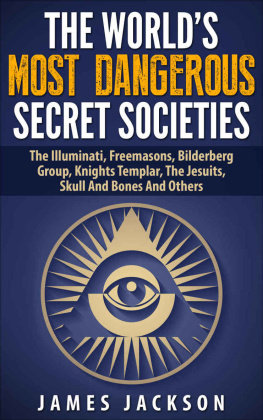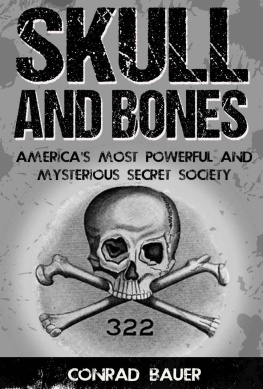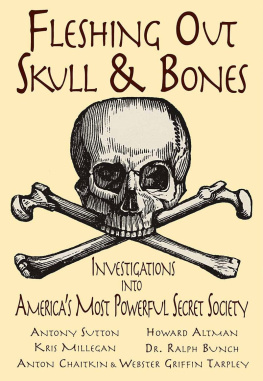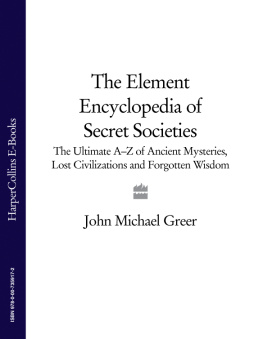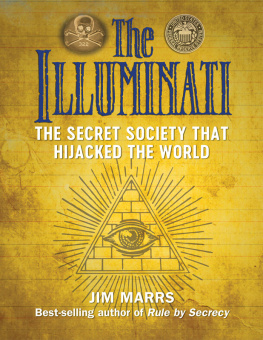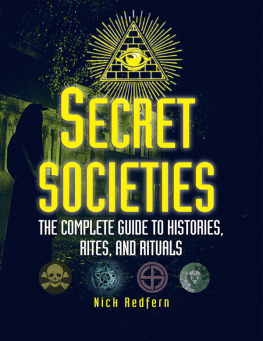The Worlds Most Dangerous Secret Societies
The Illuminati, Freemasons, Bilderberg Group, Knights Templar, The Jesuits, Skull And Bones And Others
James Jackson
Copyright 2015 by Make Profits Easy LLC
profitsdaily123@aol.com
Table of Contents
Introduction
Secret societies. To some, the name conjures up an image of a shadowy and elite cabal meeting behind smoke-filled rooms, discussing tactics of world domination and manipulation straight out of the most far-fetched espionage thriller. To others, the image of secluded men (and occasionally women!) banding together in exotic garb to perform colorful ceremonies and impart hidden knowledge and fancy but incomprehensible titles upon one another springs to mind. And to others, a fanciful and convoluted figment of the imagination sprung from only the most paranoid and incredulous minds is evoked by the title.
But just how far-fetched and fanciful is the prospect of a secret society? Could it be that there walks among us, in any given echelon of the population, groups given to exercise inordinate amounts of power and influence over the rest of us? Could these exotic members-only clubs really pose such an immediate threat to our well-being that our very way of life is endangered? At what point does the merely colorful, mysterious or deluded result in murder, mysterious deaths, unanswered disappearances, crime, extortion, control and in some cases, complete and unmitigated power?
The rationale and history behind secret societies have been amply covered in general works on the subject some purely speculative, others works of wild conjecture, and even some which have been meticulously researched and documented. Yet few adequately demonstrate the effects of these groups on society at large. And with very good reason. A secret society, by its very definition, is a group that possesses secrets; either conducive to its internal doctrine or structure, wielded as a threat or even a reward to maintain control over its members, or resulting from clandestine activities that would present a clear and present harm to the world as a whole were they ever to be revealed. Yet this definition covers a whole range of groups and practices, from the relatively mild and harmless hazing practiced by thousands of college fraternities worldwide to organized crime cartels and even low-level street gangs. What is it about the secret society of popular legend and lore that continues to hold such appealand such dangerto countless individuals in their daily lives that differentiates these shadowy entities from their more visible counterparts?
More informationand subsequently, more deliberate misinformation has been published in recent years than any time else. With the advent of the internet as a dominant means of communication, the costs and risks of revealing the tactics and methodology of formerly arcane organizations has diminished greatly. At any given time, the dedicated investigator can click on an infinite number of sites revealing a mind-bogglingly complex chain of associations that, more often than not, serve to confuse and bewilder all but the most steadfast of investigators.
Some have been adequately revealed as hoaxesthe 19th Century fraud instigated by Leo Taxil regarding the elusive Order of the Palladium springs to mind. Others are altogether figments of urban legend that have resulted in a series of bizarre coincidences and tortuous linksthe supposed Four Pi Movement alluded to by Maury Terry in his bestselling book The Ultimate Evil is one such prominent example. Yet still others have been so adequately researched, so ably presented, and whose coincidences are so improbable that one cannot help but put full faith in the veracity of at least some of these claims. Perhaps separating the fact from the fancy is one of the biggest dilemmas in adequately chronicling the danger of a secret society. And perhaps, that is but one of the goals of their effective operation.
Fear of repercussion is at the core of the concealment and mysteries of a secret society. And with good cause. Many of these groups hold basis in ideological tenets that are not only firmly accepted by popular convention, but in some cases, diametrically opposed to ittenets that in not so distant times, were punishable by persecution and even death. In our more skeptical, materially driven times, we are given to take the world of appearances solely at face value, as ipso facto. We neglect to remember that for many of our ancestors, the world of appearancesthe phenomenological world as we know itwas an allegory that alluded to much deeper, almost incomprehensibly profound truths that shaped our thinking in radical ways. This link is at the heart of the often-quoted Hermetic aphorism: As above, so below. Flying as it did in the face of official Church and State-ruled forms of discourse, adherents could risk the most dire forms of persecution merely for venturing these views, and subsequently had to work under the mantle of strict secrecy, being driven underground in the face of reformations and inquisitions where they fermented, often forging links with one another and developing a highly dubious and complex lore.
Yet scoff as we may at such unsophisticated, mystical forms of magical thinking, we neglect to remember that many of its adherents went on to influence the world in dramatic ways. The Greek philosopher Pythagoras, who is credited with introducing geometric theorems into the world, was one such member of a mystery school indeed, a secret society where revelation of secrets was punishable by death. The Elizabethan scholar, magician, and court astrologer to Queen Elizabeth I, John Dee was one such proponent of Hermetic thought, and his advice to Queen Elizabeth regarding the invasion of the Spanish Armada in 1588 is largely why English is the dominant language in North America. Many of the leading ideologues and artists of the Italian Renaissance were profoundly influenced by Hermetic themes; and even the noted father of scientific rationalism and father of Enlightenment Sir Isaac Newton had a long-standing interest in Hermetic and Alchemical treatises. And the Masonic involvement of such U.S. founding fathers as Paul Revere, George Washington and Ben Franklin has been sufficiently documented elsewhere. Are we to hold these tenets, as far-fetched and superstitious as they may seem, to be bygone relics of a distant and unenlightened era? Or has their influence on world history been actually more prevalent than appearances lead one to believe?
Yet, fears of repercussion can lead to more legitimate, even sinister concerns than merely unpopular or superstitious belief. Is the very clandestine nature of such organizations masking intents that are detrimental to the well-being of society as a whole? Has their infiltration into every spectre of political thought and action become so widespread that they are an entrenched, if subterranean, part of our current world structure? Are their agendas borne out of domination and the need for revenge? Do their actions compromise the integrity of any free-thinking and upstanding social mechanism? In a time in which public discourse allows for the open (if critical) exchange of ideas and thoughts, what is so dangerous that members conceal their identity in dire oaths of secrecy? In short, what are these societies trying to hide?
The fact is, the trails of these societies can lead to some disturbing associations and occurrences and paint a much more damning picture than mere unconvention. Trails of murder, crime, political intrigue and conspiracy are so prevalent that merely painting them as purveyors of an unsophisticated belief system is to betray the very dangers that they pose. Some of the most seemingly innocuous and benign organizationssuch as the Society of Jesuitsspin a much more dire and noxious web of deceit than you would ever think to imagine upon critical examination, as you will soon find out.
Next page
